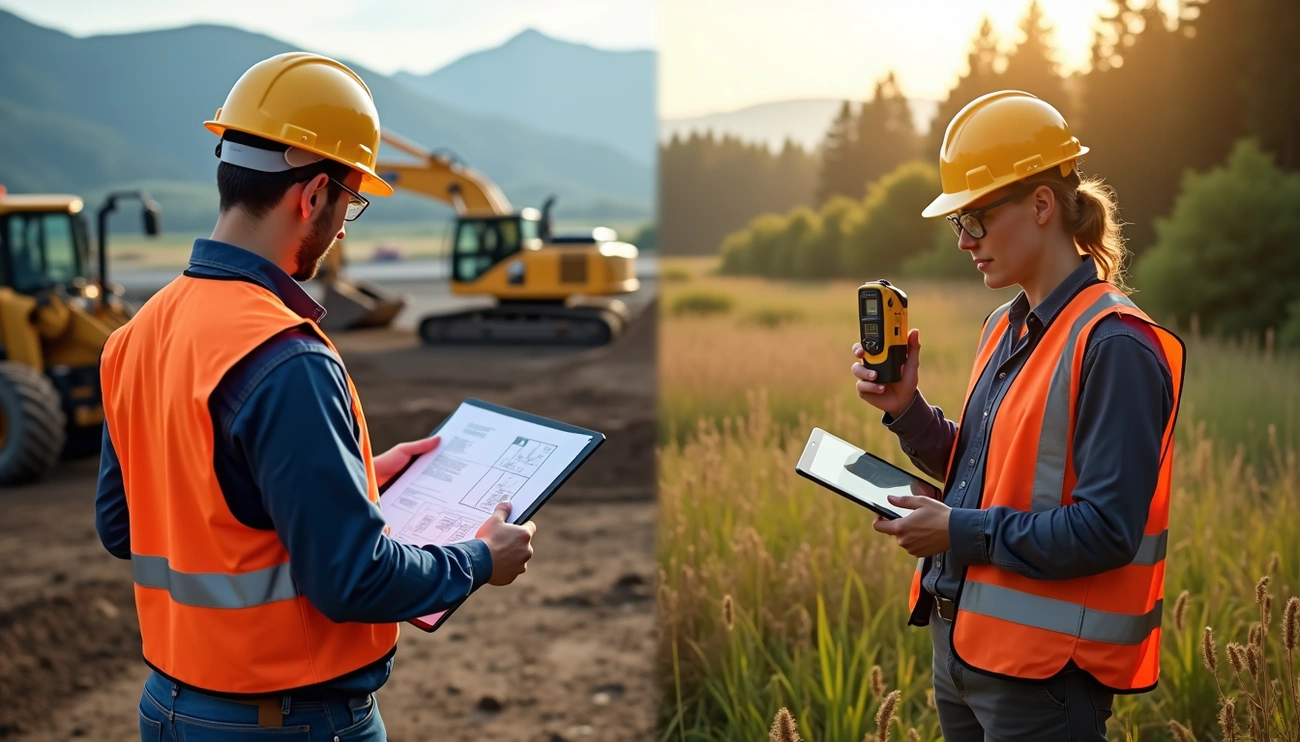- Understanding Environmental Impact Analysis in 2025
- Legal and Regulatory Frameworks Shaping EIA
- The Environmental Impact Analysis Process Explained
- The Environmental Impact Analysis Process Explained
- Expert Methods for Environmental Impact Analysis in 2025
- Stakeholder Engagement and Public Participation
- Global Practices and Case Examples
- Conclusion
- Key Takeaways
- FAQs
The United States processes roughly 50,000 Environmental Assessments and 500-600 Environmental Impact Statements each year. Environmental impact analysis has evolved into the lifeblood of eco-friendly development since 1969, when the National Environmental Policy Act (NEPA) gave it formal status.
A systematic process analyzes the predicted environmental effects of proposed projects through ecological impact analysis. Decision-makers use this crucial evaluation to understand the implications before implementation. The analysis typically measures environmental impacts using greenhouse gas emissions, which are expressed as CO2 equivalents per year.
Multiple stages make up the detailed environmental impact analysis process, from original scoping to final decision-making. Environmental Impact Statements provide the most rigorous analysis, while Environmental Assessments act as “mini-EIS” documents that determine if a complete assessment is needed. This piece outlines advanced methods for environmental impact analysis, regulatory frameworks for these assessments, and practices that professionals should become skilled at by 2025 to involve stakeholders effectively.
Understanding Environmental Impact Analysis in 2025
Environmental impact analysis: definition and scope
Environmental impact analysis helps predict, assess, and reduce potential risks of proposed projects before they begin [1]. The process examines the potential impact of projects on air quality, water bodies, biodiversity, community health, and resource use. By 2025, this field will have seen significant changes with remote sensing and AI-enabled environmental monitoring that gives immediate, long-term insights [1].
Environmental Impact Assessment (EIA) works through process-based regulation. Organizations achieve compliance through systematic methods and stakeholder involvement rather than following strict outcomes [2]. Local communities can voice their concerns through EIAs, which gives vulnerable groups a chance to shape planning decisions [1].
Difference between EIA and SEA
EIA and Strategic Environmental Assessment (SEA) serve different purposes [3]. EIAs examine specific projects, such as railway construction, highways, or industrial installations, and their environmental impacts [3]. SEA takes a broader view of public plans and programs across sectors like agriculture, forestry, energy, and industry [3].
SEA operates at a higher planning level, typically encompassing multiple projects that each require their own EIA [3]. A transport infrastructure program might include several railways or highways. An energy strategy could cover various projects from thermal power plants to hydropower installations [3].
These assessments differ in key ways:
- EIA responds to development proposals, while SEA shapes them [3]
- EIA checks how development affects the environment, while SEA examines how environmental conditions influence development opportunities [3]
- EIA spots project-specific effects, while SEA creates frameworks to measure these effects [3]
Why EIA matters in the 2025 regulatory context
EIAs play a vital role in the regulatory landscape of 2025. They help authorities make better decisions by explaining the environmental risks of proposed developments and suggesting alternatives and protection measures [3]. Early identification of potential effects helps prevent environmental damage [3].
Today’s regulations require most urban developments to complete formal EIAs [1]. This requirement shows how EIAs help address today’s challenges like climate change, biodiversity loss, and pollution—often called the “triple planetary crisis” [4].
EIAs have grown beyond just following procedures. They now focus on making informed decisions and influencing policy processes [2]. Modern tools have changed how we conduct and document EIAs, allowing teams to track projects continuously [1].
Legal and Regulatory Frameworks Shaping EIA
Legal frameworks serve as the backbone of environmental impact analysis worldwide. These frameworks have evolved over decades, providing clear procedures, standards, and guidelines that facilitate the consistent application of environmental assessments worldwide.
NEPA and CEQ guidelines for EIA
The National Environmental Policy Act (NEPA) serves as the cornerstone of environmental protection in the United States. Congress enacted NEPA in 1969, which requires federal agencies to assess ecological effects before significant federal actions [5]. This “action-forcing” legislation sets specific procedural requirements that agencies must follow [5].
The Council on Environmental Quality (CEQ) gave binding regulations for NEPA implementation until 2025. Executive Order 14154 changed this in January 2025 by revoking the regulatory authority. CEQ’s interim final rule then rescinded these regulations on April 11, 2025 [6]. NEPA still requires agencies to identify and disclose relevant environmental information early when making decisions [5].
EIA Directive 2014/52/EU and global equivalents
Directive 2014/52/EU guides the European Union’s approach to environmental assessment. This directive amended its predecessor, 2011/92/EU, to create stronger assessment procedures [7]. Member states now follow minimum requirements for project assessment, developer obligations, and public participation protocols [7].
The EU framework requires policymakers to assess climate change effects, resource efficiency, biodiversity protection, and disaster risks [7]. The EU directive differs from the U.S. system by specifically requiring marine environment assessment, with particular focus on technologies like seismic surveys [7].
Spain adopted Law 21/2013 as its national version of these EU directives. This law creates procedures to assess significant environmental effects of projects, plans, and programs [4].
Environmental justice under Executive Order 12898
Executive Order 12898, signed in 1994, brought environmental justice into U.S. regulatory frameworks [8]. Federal agencies must now identify and address any health or environmental effects that disproportionately affect minority and low-income populations [8].
The EPA Administrator chairs an Interagency Working Group created by this order. This group guides the implementation of environmental justice strategies [8]. Agencies must develop strategies that boost enforcement of ecological statutes in affected areas, encourage public participation, and enhance research data collection [8].
Different administrations have interpreted this order differently over time. The core requirement remains unchanged: federal agencies must conduct health or environmental activities without excluding, denying benefits to, or discriminating against populations based on race, color, or national origin [8].
The Environmental Impact Analysis Process Explained
The Environmental Impact Analysis Process Explained
The federal environmental impact analysis process follows a precise sequence of activities. Each activity has specific timeframes and documentation requirements. The systematic approach provides a comprehensive evaluation of potential environmental changes.
Scoping and Notice of Intent procedures
A federal agency starts the environmental impact analysis process by publishing a Notice of Intent (NOI) in the Federal Register [9]. This announcement tells the public about the upcoming environmental analysis and starts the scoping period [3]. The agency works together with communities, stakeholders, and experts to define issues and potential alternatives [3]. This early participation helps identify relevant concerns and removes non-substantive issues from further study [10]. Scoping information includes the proposed purpose and need, a description of potential alternatives, preliminary environmental impacts, and details about opportunities for public participation [9].
Draft EIS and public comment period (45 days)
The agency prepares a draft Environmental Impact Statement (EIS) after scoping ends. The draft details the proposal, the affected environment, and the analysis of predicted environmental effects [3]. The public gets at least 45 days to review and comment on this document [3]. The Environmental Protection Agency (EPA) announces the document’s availability through a Notice of Availability in the Federal Register. This announcement starts the comment clock [11]. The agency holds public hearings in communities the proposed action might affect [12]. Stakeholders of all types get a vital chance to provide substantial feedback during this phase.
Final EIS and Record of Decision (ROD)
The agency considers all substantial feedback and conducts further analysis if necessary [3]. A final EIS comes next, with responses to public comments [3]. Publication starts a minimum 30-day “wait period” before the agency makes a final decision [11]. The process ends with a Record of Decision (ROD) [3]. The ROD must have:
- The agency’s environmental decision
- Identification of all alternatives considered
- Factors are balanced in the decision-making process
- Explanation of measures to avoid or minimize environmental harm [13]
Finding of No Significant Impact (FONSI) criteria
The agency might issue a Finding of No Significant Impact (FONSI) instead of a full EIS if the environmental analysis shows no significant impacts [3]. This happens after completing an Environmental Assessment (EA) [14]. A FONSI document shows specific reasons why the agency believes no significant environmental impacts will occur [3]. The determination looks at context and intensity of the potential effects. It evaluates them against significance criteria in 40 CFR 1508.27 [15]. Federal agencies of all types regularly issue FONSIs for projects from infrastructure upgrades to resource management activities [16].
Expert Methods for Environmental Impact Analysis in 2025
Advanced methodologies are essential to address complexity and uncertainty in modern environmental impact analysis. Several innovative approaches have become standard practice among professionals by 2025.
Use of fuzzy logic in impact prediction
Fuzzy logic provides a powerful solution to handle inherent ambiguity in environmental impact assessments. This technique helps quantify and classify environmental impacts that have subjective characteristics [17]. Environmental impacts often contain uncertainty because ecological systems’ vital elements and their interactions can’t be identified precisely with crisp values [17]. Fuzzy inference systems convert original indicator values into fuzzy data and combine them into general indicators [2]. The computed fuzzy values are then defuzzified into crisp numbers to provide final indicator values [2]. This approach helps modify uncertainty that consistently challenges traditional EIA methods [17].
Life Cycle Assessment (LCA) for industrial projects
Life cycle assessment measures environmental effects in all stages of a product or system. The process starts from raw material extraction and continues through manufacturing, use, and final disposal [1]. Industrial projects’ environmental footprints are quantified by measuring greenhouse gas emissions, resource usage, and waste generation [1]. The assessment follows four main phases: goal and scope definition, life cycle inventory, impact assessment, and interpretation [1]. LCA expands traditional EIA by tracking effects outside site boundaries and explores what happens before and after a project [1]. This method has proven especially valuable for industrial facilities, as shown in a furniture production plant case study [18].
GIS-based spatial analysis for site selection
Geographical Information Systems let users store, integrate, analyze, and display spatial data for environmental impact assessment [19]. GIS-based scoping uses two databases: a thematic database that connects environmental elements with potential project impacts, and a spatial database with geographical datasets [19]. The system helps visualize possible affected sites and shows the maximum extent of the likely effects, like noise levels or air pollution [19]. A case study revealed that GIS-based scoping identified impacts that traditional EIS didn’t address, including potential effects on a nearby water reservoir [19].
Hydropower Sustainability Assessment Protocol (HSAP)
The Hydropower Sustainability Assessment Protocol is a specialized tool that assesses hydropower projects based on social, environmental, technical, and economic criteria [20]. HSAP was developed between 2007 and 2010 after reviewing various international standards and represents what multiple stakeholders agree on for sustainable hydropower development [21]. The protocol covers every project lifecycle stage: planning, preparation, implementation, and operation [20]. HSAP is “the most practical and effective tool currently available for measuring and communicating good practice” for hydropower projects [22].
Stakeholder Engagement and Public Participation
Stakeholder involvement is the foundation of successful environmental impact analysis. Projects should reflect community needs while addressing environmental concerns through public participation in decision-making.
Public hearing requirements under 40 CFR 1506.6
Federal regulations spell out specific protocols for public involvement in environmental impact analysis. Agencies need to make “diligent efforts” to get the public involved in NEPA procedures [23]. Draft Environmental Impact Statements require a minimum 45-day comment period [5]. Public hearings become necessary when there’s substantial environmental controversy or the public shows significant interest in the proposed action [23]. Agencies must inform the public about hearings through local newspapers, direct mailings, and online platforms to reach affected communities [23]. Local actions need nine specific ways to notify people, including tribal communities and posting notices at the action site [5].
Community outreach strategies for vulnerable populations
Working with marginalized communities needs special engagement approaches. Good outreach should help non-English speaking populations through translated materials and interpreters [24]. Meeting locations matter too. The best spots are community centers, schools, and churches where vulnerable groups feel at home [24]. Here are some strategies that work:
- Designating community liaisons for specific populations [5]
- Setting up resource hubs within study areas [5]
- Creating focused, equitable services that boost preventive healthcare use [25]
Research shows targeted outreach programs help improve health equity indicators among vulnerable populations by a lot [25]. Notwithstanding that, no single engagement strategy works in a variety of communities [26].
Role of third-party contractors in EIS preparation
Third-party contractors help federal agencies create environmental documents while staying independent. These contractors work under the agency’s direction even though project applicants pay them [27]. The agency selects the contractor, rather than the applicant, to prevent conflicts of interest [27]. Contractors take on many tasks like scoping assistance, public meeting coordination, and document preparation [7]. They must sign disclosure statements to confirm they don’t have financial interests in the project’s outcome [23]. While contractors assist with technical aspects, the agency retains full responsibility for the document’s content and makes all final decisions regarding scope, methodology, and conclusions [27].
Global Practices and Case Examples
Environmental impact analysis rules and enforcement vary significantly between countries, showing how different governments prioritize and manage these assessments.
EIA implementation in Australia and Canada
Australia, Canada, and New Zealand were the first countries to follow the United States’ NEPA example by adopting environmental impact analysis systems in 1973-1974 [4]. Australia chose to implement these requirements through national laws [4]. The Canadian government took a different approach and focused on administrative implementation instead of creating detailed legislative frameworks [4]. These 50-year-old systems became models that shaped how other countries developed their assessment practices [28].
China’s enforcement challenges and penalties
China struggles to enforce its environmental impact analysis rules, despite having strong laws in place. Many construction projects used to begin without getting EIA approvals from environmental agencies. This led the government to launch “environmental storms” or “EIA storms” to fix these systemic problems [29]. China now uses a mix of administrative, criminal, and civil penalties to enforce compliance [30]. Violators face criminal charges and must pay for environmental damage. Some cases have resulted in prison time and significant financial penalties, which shows how serious enforcement has become [30].
EU Annex I vs Annex II project classification
The European Union uses two categories in its Environmental Impact Assessment Directive. Annex I covers major projects that always need environmental impact analysis because they affect the environment substantially. These include large thermal power stations (over 300 megawatts), nuclear plants, oil refineries, long-distance railways, and major airports [8]. Annex II projects undergo a “screening procedure,” where local authorities determine the need for an EIA based on specific criteria or through a case-by-case review [8]. Some Annex II projects are smaller versions of Annex I projects, while others, like hydropower installations and urban development projects, only appear in Annex II [8].
Conclusion
Environmental impact analysis has changed by a lot since NEPA introduced it in 1969. It has become a key part of green practices worldwide. This piece explores the detailed process that shapes environmental assessments. The process spans from original scoping and public notices to final decision-making documents.
Modern societies protect the environment at multiple levels. This shows in the difference between project-specific Environmental Impact Assessments and broader Strategic Environmental Assessments. Countries around the world recognize the need for environmental impact analysis. NEPA guides this work in the United States, while Directive 2014/52/EU leads Europe. Australia, Canada, and China have similar frameworks.
New methods now help environmental assessments work better. Fuzzy logic helps predict uncertain impacts, and Life Cycle Assessment looks beyond project limits. GIS-based spatial analysis picks sites with precision. Specialized tools like the Hydropower Sustainability Assessment Protocol guide specific sectors.
Getting stakeholders involved remains crucial for meaningful environmental assessment. Public hearings and community outreach programs create inclusive decision-making. These programs consider various perspectives and protect vulnerable groups. Third-party contractors also play a vital role.
Nations of all sizes adapt their approaches based on local needs and priorities. They may use different systems, enforcement methods, and strategies. Yet they share the same goals of protecting nature and supporting sustainable growth.
Environmental impact analysis serves as both a technical field and a democratic process. The methods for 2025 show better technology and greater social awareness. Experts who know these approaches help balance development with environmental protection. Their decisions today save resources for tomorrow’s generations.
Key Takeaways
Master these essential environmental impact analysis methods to navigate the evolving regulatory landscape and deliver comprehensive assessments that balance development with environmental protection.
• Environmental Impact Analysis requires systematic evaluation of air, water, biodiversity, and community impacts before project implementation, with 50,000+ assessments filed annually in the US alone.
• Advanced 2025 methodologies include fuzzy logic for uncertainty management, Life Cycle Assessment for comprehensive impact tracking, and GIS-based spatial analysis for precise site selection.
• Legal frameworks vary globally: NEPA governs US federal projects, EU Directive 2014/52/EU harmonizes European standards, while enforcement mechanisms differ significantly across jurisdictions.
• Effective stakeholder engagement demands 45-day minimum comment periods, targeted outreach to vulnerable populations, and strategic use of third-party contractors to maintain assessment independence.
• Strategic Environmental Assessment (SEA) addresses broader plans and programs across multiple sectors, while Environmental Impact Assessment (EIA) focuses on specific project-level consequences and mitigation measures.
The integration of AI-enabled monitoring, real-time data collection, and enhanced public participation tools positions environmental impact analysis as both a technical discipline and a democratic process essential for sustainable development in 2025 and beyond.
FAQs
Q1. What is Environmental Impact Analysis, and why is it important in 2025? Environmental Impact Analysis is a systematic process that predicts and assesses the potential environmental consequences of proposed projects before implementation. It’s crucial in 2025 as it informs decision-making, helps prevent environmental damage, and addresses contemporary challenges like climate change and biodiversity loss.
Q2. How does the Environmental Impact Assessment (EIA) process work? The EIA process typically involves several stages: scoping and publishing a Notice of Intent, preparing a draft Environmental Impact Statement (EIS), allowing for a 45-day public comment period, finalizing the EIS, and issuing a Record of Decision (ROD) or a Finding of No Significant Impact (FONSI) if applicable.
Q3. What are some expert methods used for Environmental Impact Analysis in 2025? Expert methods in 2025 include fuzzy logic for impact prediction, Life Cycle Assessment (LCA) for industrial projects, GIS-based spatial analysis for site selection, and specialized tools like the Hydropower Sustainability Assessment Protocol (HSAP) for specific sectors.
Q4. How does stakeholder engagement factor into Environmental Impact Analysis? Stakeholder engagement is crucial in Environmental Impact Analysis. It involves public hearings, community outreach strategies (especially for vulnerable populations), and the use of third-party contractors for EIS preparation. This ensures diverse perspectives are considered and helps balance development needs with environmental protection.
Q5. How does Environmental Impact Analysis implementation differ globally? Implementation varies significantly across countries. For instance, Australia and Canada were early adopters with different regulatory approaches. China faces unique enforcement challenges and has implemented strict penalties. The European Union uses a two-tier classification system (Annex I and II) for determining which projects require mandatory environmental impact analysis.
Our carbon experts help production studios frame strategy, train teams and track results — tailored to operational constraints.





